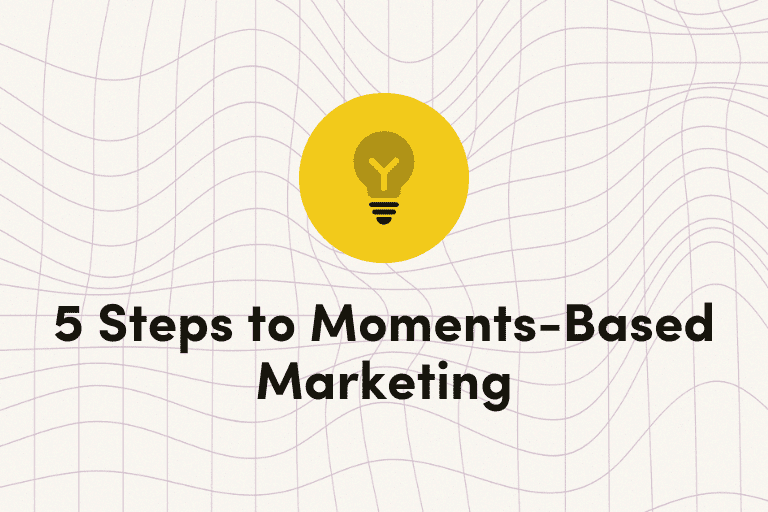Most brand marketers are well-versed in the foundational consumer communication channels, like email, SMS, and mobile push notifications. But there’s one channel that’s often overlooked but can deliver a major impact: web push, also known as browser push.
So today we’re going to dive into the basics of web push and the benefits it can bring to any cross-channel marketing program.
What are Web Push Notifications?
Web push notifications are messages that you can send to a browser, either desktop or mobile, from a central messaging platform, like Iterable. Once a user has visited your website and opted-in to receive them, they can be notified wherever they are on the web. As long as they have a browser like Chrome or Firefox open on their smartphone, tablet, or computer, they can be sent a notification.
Similar to mobile push, the goal of these messages is to entice people to re-engage with your website or brand. With their limited space, you can include a bit of text, an image, and a call-to-action that links to a webpage or app screen containing further information.
Common use cases for web push include:
- Promotions about exclusive offers, flash sales, or discounts
- Content updates about new blog posts or articles related to user interests
- Event reminders about upcoming occasions or important dates
- Cart abandonment alerts enticing shoppers to complete their purchases
- Feedback requests asking customers to rate or review products and services
- Transactional communications regarding order status or delivery
Before we cover how exactly to incorporate web push into your marketing strategy, let’s dispel some myths. If you think these messages are nothing but annoying pop-ups, think again.
The Stats You Need to Know
It can be easy to dismiss web push notifications, both figuratively and literally, but research shows why that would be a mistake:
- Ecommerce is the industry with the highest usage of web push. 22.3% of ecommerce brands are utilizing the channel, compared to media & publishing at 18.79% and insurance at 8.35%. Travel and hospitality ranked as one of the industries that use web push the least at 2.61%.
- Open or view rates are high. Browser notifications show an open or view rate from 45-90%, compared to the average for email newsletters at 15-30%. Adding emojis in the copy was also shown to improve open rates by 20%.
- An early web push gets the click. 39% of subscribers say they prefer receiving browser notifications in the morning and another 15% appreciate updates while they’re commuting to work. Personalizing the send time to a user’s preferences has shown to increase reaction rates by 40%.
Overall, web pushes are timely messages that generate high engagement and broad reach. By bypassing the need for users to visit your website on a regular basis or download an app, your brand can communicate with your audience directly and efficiently, driving immediate response.
Best Practices of Web Push
Now that we’ve convinced you that web push is worth incorporating into your cross-channel strategy, let’s discuss using this channel properly. Because with great power comes the great responsibility of making sure your users don’t regret signing up.
- Ask for opt-in strategically. Like other marketing channels, users must opt-in to receive web push notifications. This can be done through a hard opt-in via a straightforward yes/no prompt or a soft opt-in that uses two dialogue boxes to explain the benefits of opting in before prompting. The soft opt-in generally yields better results because it educates users on the value of the notifications you’ll send before seeking their consent.
- Diversify with cross-channel marketing. Compound the effects of your campaigns by managing web push alongside other channels, such as email, SMS, mobile push, in-app messages, and even direct mail. Each has unique value, so consider how to create cross-channel touchpoints along your entire customer journey.
- Personalize your pushes. These pop-ups can pack a major punch if you tailor your messages to each user’s interests and preferences. If you’re using Iterable, web push notifications can be customized with user profile data, event data, data feeds, and Catalog data.
- Don’t be afraid to experiment. Not only should you A/B test your soft opt-in and copy to maximize your sign-up rates, but you should create experiments to find out what types of messages resonate best with your audience.
- Send with respect. As always, show that you have your customers’ best interests in mind. Use web push sparingly, especially on mobile where browser notifications can be seen as more intrusive. And avoid disturbing users at inconvenient times by using Quiet Hours to pause sends during specified hours.
Add Web Push to Your Toolkit Today
Web push or browser push notifications are one of a marketer’s most valuable tools in their cross-channel marketing toolkit, offering a direct, timely, and engaging way to communicate with users. By understanding their mechanics and adhering to best practices, you can send notifications that convert on a grand scale.
For more information, be sure to check the following resources:
- Support Article: Web Push Overview
- Support Article: Creating Web Push Templates
- Academy Course: Creating a Web Push Campaign
And if you’d like 1-on-1 guidance on implementing your next campaign, our experts at Iterable are here to help.
Interested in adding web push to your marketing campaigns? Request a demo of Iterable’s leading cross-channel customer communications platform.
































